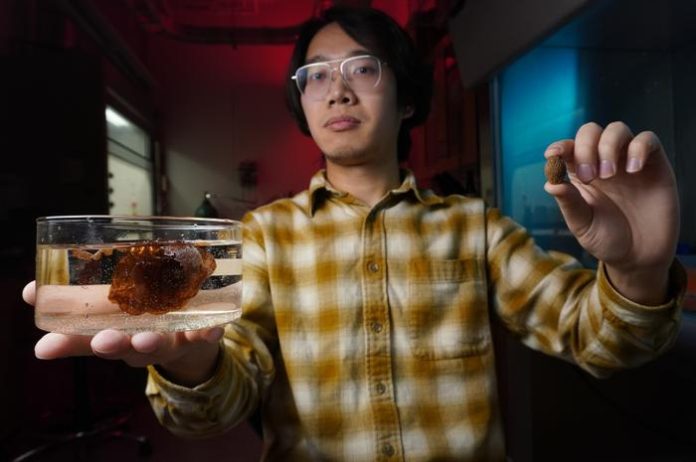A University of Chicago graduate student has discovered that a humble nut used in herbal tea could revolutionize medical devices, turning what most people throw away into powerful tools for healthcare. The research, published today in Matter, shows how the gelatinous leftovers from malva nut tea can be engineered into advanced materials for everything from wound healing to heart monitoring.
The malva nut, known in Chinese medicine as Pangdahai, has an extraordinary ability to expand in water – swelling up to 20 times its original weight. While most people discard the resulting jelly after drinking the tea, PhD student Changxu Sun saw untapped potential.
“You never saw the fruit from a tree expand in that kind of volume,” said Sun, who led the research at the University of Chicago’s Pritzker School of Molecular Engineering. “Originally, it’s an oval shape one centimeter in width. Once you soak it in the water, it will expand about eight times in volume and 20 times by weight, turning into a gelatinous mass, like a jelly.”
This remarkable expansion far exceeds other natural materials – rice expands only three times when cooked, while even chia seeds manage just 10 times their original weight. The research team transformed this natural phenomenon into a sophisticated hydrogel – a water-based material that mimics human tissue and can be used in various medical applications.
University of Chicago Chemistry Professor Bozhi Tian, who supervised the research, praised Sun’s innovative thinking: “It is a remarkable discovery from a remarkable student. Changxu looked at herbal tea and saw a world of sustainable biomedical applications ready to be built.”
The team developed a process to extract the useful components from the nuts, removing the hard outer shell materials and creating a pure, freeze-dried scaffold that springs back to life when water is added. Testing showed the resulting hydrogel performed better than commercial products in several medical applications, particularly in recording heart signals through ECG patches.
“We found it demonstrated superior performance and qualities compared to commercial ECG patches. And then we also applied to the tissue surface in vivo, demonstrating great recording of biosignals,” Sun explained. “We wanted to show people should shift their attention into the unexplored properties and unexplored resources of natural plants.”
The discovery could have particular impact in Southeast Asian nations where the malva tree is native. Sun sees potential for these countries to develop valuable medical resources from a local material, providing both healthcare solutions and economic opportunities.
“They’re low-income countries. Their healthcare systems are always limited by this lack of resources,” Sun noted. “Here we have a local, native material that can be used to create valuable healthcare solutions while providing these impoverished areas some economic stability.”
The research team’s method focuses on sustainability, using minimal processing to transform the nut waste into medical-grade materials. The resulting hydrogel has shown promise in multiple applications, from wound dressings that promote healing to bioelectronic interfaces that can monitor heart activity.
This work represents a broader trend in medical research toward finding sustainable, natural alternatives to synthetic materials. The success with malva nuts suggests other plant-based materials currently considered waste might hold similar potential for medical applications.
The discovery could lead to more affordable medical devices in regions where traditional healthcare resources are scarce, while simultaneously creating value from what was previously considered waste. It’s an approach that combines environmental sustainability with medical innovation, turning yesterday’s tea dregs into tomorrow’s medical technology.
If you found this piece useful, please consider supporting our work with a small, one-time or monthly donation. Your contribution enables us to continue bringing you accurate, thought-provoking science and medical news that you can trust. Independent reporting takes time, effort, and resources, and your support makes it possible for us to keep exploring the stories that matter to you. Together, we can ensure that important discoveries and developments reach the people who need them most.




